| Pages:
1
..
46
47
48
49
50
..
60 |
gdflp
Super Moderator
      
Posts: 1320
Registered: 14-2-2014
Location: NY, USA
Member Is Offline
Mood: Staring at code
|
|
@nux vomica
What temperature are you heating the phosphorus mixture at in your forge? Also, how easy is it for you to reuse one of your retorts?
|
|
|
nux vomica
Hazard to Others
  
Posts: 267
Registered: 18-7-2013
Member Is Offline
Mood: No Mood
|
|
Gdfp going by eye and looking at a temp chart it looks to be between 950 and 1000 C i have a 1200w element in it but i have a variable temp controller
and its only putting out 1000w when running the forge, there seems to be no probs reusing the retorts just buff of any scale where you are welding, a
tig can weld some pretty shitty covered steel if you have to but a cleaned up retort welds like new. cheers Scott
|
|
|
nux vomica
Hazard to Others
  
Posts: 267
Registered: 18-7-2013
Member Is Offline
Mood: No Mood
|
|
Right the results are in but not sure how accurate they are, for the retort with lime i got 1.35 gms of phosphorus, and for no lime 1.75 grms, the no
lime retort seemed to also be really reacting well as there was a lot of phosphorus being wasted and burning up in the air after passing through the
water used a new element and think temp was to high measured at 945 deg c with
probe, you get the same effect if you heat the outlet with a gas torch the phos seems to volatile and wont condense and just passes through the
system, will play with settings when i get a chance cheers nuxy used a new element and think temp was to high measured at 945 deg c with
probe, you get the same effect if you heat the outlet with a gas torch the phos seems to volatile and wont condense and just passes through the
system, will play with settings when i get a chance cheers nuxy
|
|
|
nux vomica
Hazard to Others
  
Posts: 267
Registered: 18-7-2013
Member Is Offline
Mood: No Mood
|
|
Had three more goes for the return of 2, 2.3, 2.65 grm phosphorus used a glass tube leading into the water and found the phosphorus condensed on the
glass and will run down the tube if you heated gently with a gas torch occasionally much better way to do it.
Took a pic of map and coke mix didnt crush them up but mix and seal in retort, arc welded tube at home useing 2.5 m/s rods.
Cleaned all the phosphorus up in chromic sulfuric acid mix total is 15.48 grm dont even really need that much so might see if i can turn it into red
phos seems a bit more usefull and stable than the white version cheers nuxy.
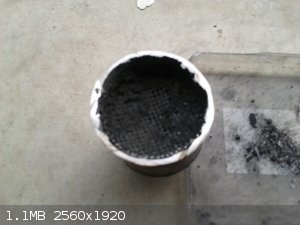 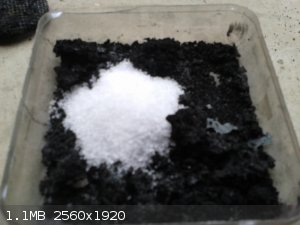 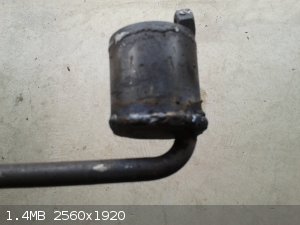 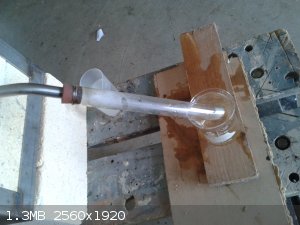 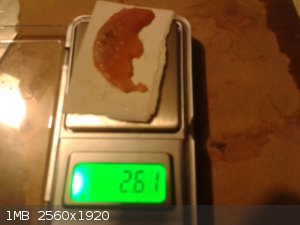 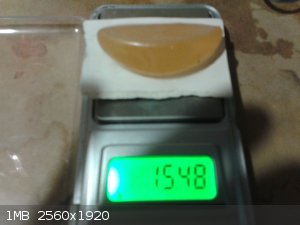
[Edited on 26-9-2014 by nux vomica]
[Edited on 26-9-2014 by nux vomica]
|
|
|
Amos
International Hazard
    
Posts: 1406
Registered: 25-3-2014
Location: Yes
Member Is Offline
Mood: No
|
|
Quote: Originally posted by j_sum1  | I'm late to the discussion and haven't read the whole thread so forgive me if this has been covered before.
If the purpose is to obtain a small sample for element collection (ie, volume created is not critical) then there is a straightforward method.
Red Phos can be gotten by scraping matchboxes after first loosening the glue with acetone. Tedious, impure, but possible.
Purifying and converting to white Phos is easy.
Place a small sample of red phos in a glass tube with sealed end or a small test tube.
Bung the other end with cotton wool or similar.
Heat the red phosphorus in a flame until it sublimes. It will deposit on the cotton wool. Removing the bung should demonstrate self ignition in air.
If you want to keep your sample then you need to use a longer glass tube. Place a cooling collar around the tube to force the phos to deposit in the
location you desire. Then ampoule your sample by melting the tube on either side of the sample.
You won't get more than a few milligrams this way, but if that's all you need then this method is a cinch. |
I'm pretty sure this is for larger amounts, like the ones nux vomica keeps producing above. It sounds as though this problem was cracked a couple of
years ago; now all that remains is improving the syntheses that others have posted, and making them ever more accessible to the amateur chemist.
|
|
|
Azane
Harmless

Posts: 22
Registered: 9-7-2013
Member Is Offline
Mood: No Mood
|
|
Perhaps phosphorus trichloride could be reacted with a metal phosphide...?
AlP + PCl3 --> 1/2P4 + AlCl3
Let me know if this is a terrible idea.
|
|
|
Arcuritech
Harmless

Posts: 34
Registered: 19-8-2012
Location: Scraping fused boria from a crucible.
Member Is Offline
|
|
Quote: Originally posted by Azane  | Perhaps phosphorus trichloride could be reacted with a metal phosphide...?
AlP + PCl3 --> 1/2P4 + AlCl3 |
This raises the problem of trying to obtain PCl3. It can't be made by the standard industrial route because that uses phosphorous as a
precursor, and it's controlled as a schedule 3 under the chemical weapons convention so I'm almost certain nobody will sell it to a non-corprate and
non-government buyer.
"If we knew what we were doing, it wouldn't be called research." -Albert Einstein
"There are few things -- whether in the outward world, or, to a certain depth, in the invisible sphere of thought -- few things hidden from the man
who devotes himself earnestly and unreservedly to the solution of a mystery." -Nathaniel Hawthorne ("Roger Chillingworth")
|
|
|
tim
Harmless

Posts: 1
Registered: 25-10-2014
Member Is Offline
Mood: No Mood
|
|
this worked
Hi...I thought i would like to share this after just finding this site..Ive just joined up now !
I have been fascinated by phosphorus for years and tried a few things that didnt work..however this did...
I got some phosphoric acid from a chemical company (Also easy to make,which i have, by digesting bone ash (used in pottery and available from pottery
supplies) in H2SO4) heated it in a glass beaker over a gas burner (with mesh) until it smoked meaning it was dehydrated to pyro,or is it meta? let it
cool...added about 10 times the amount of finely ground activated carbon (thats all I had on hand.I originally intended to use charcoal) then stuffed
some of the really thick paste a third of the way into a quartz domestic heater element that i had taken the coil out of and rewound on the outside (I
used a variac but other elements in series would give the possibly needed control) and heated it for about 2 hours.
When it was cold i took it into the dark and there it was...a faint glow of green...It glowed a lot more brightly when I blew into it displacing the
phosgene and other gasses protecting it from the air...I was stoked !!!....Ive been meaning to do it on a big scale but been to busy.. From what i
learned one needs to slope tube slightly upwards as goo melts before reducing and tries to run out..Block end in which you put reaction mixture with
some sealer and start winding wire 2 inches from said end so you can keep a damp rag around sealer to prevent it burning..(I used urethane but
fireclay would be way better and no wet live rag either !!..Hope someone likes this...I did !!
Im very happy to join your great site...thanks (-: Tim New Zealand
|
|
|
nhindori
Harmless

Posts: 12
Registered: 29-1-2014
Member Is Offline
Mood: No Mood
|
|
Im not sure if preparation of black phosphorus crystals has been discussed but I'm very curious as to how it its created. I know extremely high
pressure is applied or gas phase transport.
Please share some info or refer to one of the 48 pages of this thread
Photo from smart-elements
[Edited on 5-11-2014 by nhindori]
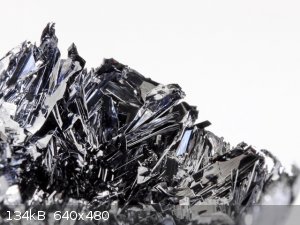
|
|
|
Pok
potassium Prometheus
  
Posts: 176
Registered: 5-12-2010
Member Is Offline
|
|
There is already a thread about black P: http://www.sciencemadness.org/talk/viewthread.php?tid=12196
This doesn't belong to "preparation of elemental P" because it's a transformation of an allotrope from another one which already is elemental P.
|
|
|
Zarynga
Harmless

Posts: 1
Registered: 5-10-2014
Member Is Offline
Mood: No Mood
|
|
Monopotassium way?
Hello. I have read about the last twenty pages, but I couldn't found an answer. Is possible to obtain phosphorus from Monopotassium Phosphate KH2PO4
or from Trisodium Phosphate Na3PO4 using similar way to Ammonium Phosphate and coal method? I have only these two chemicals available.
[Edited on 11-2-2015 by Zarynga]
|
|
|
S.C. Wack
bibliomaster
    
Posts: 2419
Registered: 7-5-2004
Location: Cornworld, Central USA
Member Is Offline
Mood: Enhanced
|
|
Add hydrogen chloride during the reduction.
|
|
|
Ramium
Hazard to Others
  
Posts: 144
Registered: 3-12-2014
Location: new zealand
Member Is Offline
Mood: Licit fish
|
|
If u heated red phosphorus in a sealed test tube to convert it to white phosphorus then opened the test tube under water the white phosphorus would
sink to the bottom.if u repeated this lots of times wouldent you get a nice amount of white phosphorus???
I dont know if this works or not.its just an idea
Do u think it would work???
|
|
|
Molecular Manipulations
Hazard to Others
  
Posts: 447
Registered: 17-12-2014
Location: The Garden of Eden
Member Is Offline
Mood: High on forbidden fruit
|
|
Pyro did basically that except the test tube was bent but open, with the open end in the water. It seemed to work decently.
http://www.sciencemadness.org/talk/viewthread.php?tid=25653
-The manipulator
We are all here on earth to help others; what on earth the others are here for I don't know. -W. H. Auden
|
|
|
Molecular Manipulations
Hazard to Others
  
Posts: 447
Registered: 17-12-2014
Location: The Garden of Eden
Member Is Offline
Mood: High on forbidden fruit
|
|
You supply phosphates but think they were made from phosphorous? Common man, nobody makes phosphates from elemental phosphorous.
-The manipulator
We are all here on earth to help others; what on earth the others are here for I don't know. -W. H. Auden
|
|
|
Magpie
lab constructor
    
Posts: 5939
Registered: 1-11-2003
Location: USA
Member Is Offline
Mood: Chemistry: the subtle science.
|
|
Certainly not for phosphate fertilizer. But IIRC elemental P is used by the carbonated beverage industry for making phosphoric acid. This is likely a
way to obtain the purity they require.
The single most important condition for a successful synthesis is good mixing - Nicodem
|
|
|
blogfast25
International Hazard
    
Posts: 10562
Registered: 3-2-2008
Location: Neverland
Member Is Offline
Mood: No Mood
|
|
Quote: Originally posted by Magpie  | But IIRC elemental P is used by the carbonated beverage industry for making phosphoric acid. This is likely a way to obtain the purity they require.
|
I'm not sure it is made by the carbonated beverage industry but high purity (incl. food grade) H3PO4 is indeed manufactured from
burning phosphorus.
|
|
|
j_sum1
Administrator
       
Posts: 6219
Registered: 4-10-2014
Location: Unmoved
Member Is Offline
Mood: Organised
|
|
Maybe this has already been covered in the multiple pages of this thread (not all of which I have read). If so, I apologise.
I came across this video which results in what looks like a yield in the tens of grams range.
Source of phosphorus is a food additive or water softener.
http://www.melbournefooddepot.com/buy/sodium-hexametaphospha...
http://www.alibaba.com/showroom/sodium-hexametaphosphate.htm...
I am still not extremely clear on the process: in particular the reason for the NaCl and SiO2 in the reaction vessel. I think the receiving vessel
has water in it, but again I am not sure. Anyway, the whole process looks reasonably accessible. I'd love some more insight if anyone has any. (Or
refer me back to the sections of this thread that I have missed.)
|
|
|
byko3y
National Hazard
   
Posts: 721
Registered: 16-3-2015
Member Is Offline
Mood: dooM
|
|
j_sum1, this is a know reaction
and also
However, I have no idea why he needed NaCl.
| Quote: | 6NaPO3 + 10 Al + 3 SiO2 = 6P + 5Al2O3 + 3Na2SiO3
Reduction is performed by heating in a heat resistant tube 25 cm long and 1-1.5 cm in diameter, connected from one side to a source of clean hydrogen
(gas cylinder or kipp's apparatus), and from the other side to a tube, which passes gaseous products into a crystallization vessel filled with water.
The heat resistant tube is filled with a mixture made from 1 weight part of NaPO3, 3 pars of SiO2 and 0.5 parts of aluminium turnings. With a help of
asbestos corks the tube is connected from one side throught a washing bottle, filled with concentrated H2SO4, to a source of hydrogen, and from
another to an outlet tube.
After removal of air from the apparatus using a strong flow of hydrogen and making sure that exiting hydrogen is pure, the heat resistant tube is
heated using a burner with wide nozzle. Phosphorus being formed by the mentioned reaction is distilled and condensed into small balls within
crystallization vessel with water. In dark you can notice a slight glowing of the phosphorus in the tube.
After the experiment is finished, the apparatus is dissasembled only after it has been completely cooled down in a flow of hydrogen.
Obtained phosphorus is put in a bottle filled with cold water.
Sodium metaphoshpate can be prepared by ammonium sodium phosphate hydrate calcination by reaction:
NaNH4HPO4*4H2O => NaPO4 + NH3 + 5H2O |
Ripan, R. and Chetyanu, I. (1972) Inorganic Chemistry
PS: although I have no idea why these very conditions are needed. Also I can point at the book which says NaPO3 + NaCl leads to HCl, Cl2 and small amounts of POCl3 at 800°C; and Lerner mentiones P2O5 + NaCl => POCl3 at 300-420°C
with perfect yield.
[Edited on 6-6-2015 by byko3y]
|
|
|
blogfast25
International Hazard
    
Posts: 10562
Registered: 3-2-2008
Location: Neverland
Member Is Offline
Mood: No Mood
|
|
Quote: Originally posted by j_sum1  |
I am still not extremely clear on the process: in particular the reason for the NaCl and SiO2 in the reaction vessel. I think the receiving vessel
has water in it, but again I am not sure. Anyway, the whole process looks reasonably accessible. I'd love some more insight if anyone has any. (Or
refer me back to the sections of this thread that I have missed.) |
This video is by rogeryermaw, who posted his stuff higher up in the thread.
The NaCl is present as a 'flux', promoting contact and mass transfer between the reagents. The SiO2 is a bit of a 'relic' from the old Ca phosphate +
C + silica method.
I'm not sure why he doesn't just use a large open pile of BBQ coal and lots of air (leaf blower, for instance).
|
|
|
Assured Fish
Hazard to Others
  
Posts: 319
Registered: 31-8-2015
Location: Noo Z Land
Member Is Offline
Mood: Misanthropic
|
|
Does anyone know the exact temperature range at which this reaction takes place
2NaH2PO4 --> Na2H2P2O7 + H2O
And also the following
3Na2H2P2O7 --> (NaPO3)6 + 3H2O
I would guess its up around 700°C but the wiki doesn't specify nor can i find anywhere that does tell me.
I also realize that it would be a hell of a lot easier to just buy sodium hexametaphosphate but for the sake of science it would be good to know the
temp range required to undergo hydrolysis of monosodium phosphate to disodium pyrophosphate and so forth just in case sodium hexametaphosphate cannot
be aquired.
|
|
|
Assured Fish
Hazard to Others
  
Posts: 319
Registered: 31-8-2015
Location: Noo Z Land
Member Is Offline
Mood: Misanthropic
|
|
Quote: Originally posted by Assured Fish  | Does anyone know the exact temperature range at which this reaction takes place
2NaH2PO4 --> Na2H2P2O7 + H2O
And also the following
3Na2H2P2O7 --> (NaPO3)6 + 3H2O
I would guess its up around 700°C but the wiki doesn't specify nor can i find anywhere that does tell me.
I also realize that it would be a hell of a lot easier to just buy sodium hexametaphosphate but for the sake of science it would be good to know the
temp range required to undergo hydrolysis of monosodium phosphate to disodium pyrophosphate and so forth just in case sodium hexametaphosphate cannot
be aquired. |
Ok so this thread is old and dead but ill post here.
169C
2NaH2PO4 -------> Na2H2P2O7
|
|
|
blogfast25
International Hazard
    
Posts: 10562
Registered: 3-2-2008
Location: Neverland
Member Is Offline
Mood: No Mood
|
|
Any evidence for your assertion?
|
|
|
Bert
Super Administrator
        
Posts: 2821
Registered: 12-3-2004
Member Is Offline
Mood: " I think we are all going to die. I think that love is an illusion. We are flawed, my darling".
|
|
Quote: Originally posted by Assured Fish  | Quote: Originally posted by Assured Fish  | Does anyone know the exact temperature range at which this reaction takes place
2NaH2PO4 --> Na2H2P2O7 + H2O
And also the following
3Na2H2P2O7 --> (NaPO3)6 + 3H2O
I would guess its up around 700°C but the wiki doesn't specify nor can i find anywhere that does tell me.
I also realize that it would be a hell of a lot easier to just buy sodium hexametaphosphate but for the sake of science it would be good to know the
temp range required to undergo hydrolysis of monosodium phosphate to disodium pyrophosphate and so forth just in case sodium hexametaphosphate cannot
be aquired. |
Ok so this thread is old and dead but ill post here.
169C
2NaH2PO4 -------> Na2H2P2O7
|
Why are you talking to yourself?
[Edited on 17-1-2016 by Bert]
Rapopart’s Rules for critical commentary:
1. Attempt to re-express your target’s position so clearly, vividly and fairly that your target says: “Thanks, I wish I’d thought of putting it
that way.”
2. List any points of agreement (especially if they are not matters of general or widespread agreement).
3. Mention anything you have learned from your target.
4. Only then are you permitted to say so much as a word of rebuttal or criticism.
Anatol Rapoport was a Russian-born American mathematical psychologist (1911-2007).
|
|
|
BluePlanet1
Harmless

Posts: 41
Registered: 30-1-2016
Member Is Offline
Mood: No Mood
|
|
Hello all! I'm a new member and if it's ok with the forum I'd like to try a few different approaches to making white P4. I have a new camera coming in
a few days for doing HD 1080P videos as my current one sucks. My plan is to tape the experiments then upload them to a proxied YT account. This way I
can stay anonymous but also show people VIDEOS of this reaction going with many different tweaks to it.
There are mainly 4 different things I'll be doing here:
1) Using HHO (oxyhydro gas) + MAP coolant + AIR propane to test and run experiments at any temperature up to 2500C - 5000F. My HHO torch is 3 cells at
4-5 LPM (each cell) with 3, 12V-75A chargers. I finally fried a breaker a couple days ago so right now the torch is only running on 1 cell. What you
see in the pic is a baby flame around 4-5LPM. Which on its own can boil & cut steel. But when everything is connected I get a surge of roughly
12-15LPM HHO on top of the MAP gas which is extraordinarily hot and cuts through 1/4" steel like butter. It really is powerful. When I change the tip
to .035 the flame is at least 14+ inches. Which you'll see when I get my breaker fixed & get some advice from the electrician.
The main benefit of HHO is that the water (fuel) really does last forever. So there's no need to refill any gas tanks. The torches aren't really
"cheap", but you can set up a powerful hobby torch for $150-$300 (or cheaper if you build the cells yourself). I should mention too, my goal is to use
HHO just for testing. I want my final method to rely on simple air-MAP gas accessible by anyone.
2) Instead of using pure AL powder (500 mesh) I want to test a mixture of 50% AL, 20% MG, 30% C. I have a theory I'll talk about in #4.
3) When my camera gets here I'll be replacing all text & pics with video.
4) I'm going to start with a few "normal" reactions first. Then I'm going to set up a "rocket distiller". I believe one of the big problems with this
reaction is the RELEASE of heat energy in the form of >>>pressure. I believe for every unit of energy that escapes in the form of pressure,
that's 1 less unit the AL has to not only keep the sodium silicate and aluminum oxide molten and finishing their reactions.... but to CONTINUE &
COMPLETE the process of reducing P4O10 to WP.
I believe this is a serious problem! Why? Because I've set this reaction of many times on a small scale by igniting it with either HHO or air-MAP. I
notice the reaction will fire off (then I pull the heat away on purpose to see how far it goes on its own). Then when I add air-MAP the reaction
starts up again. However, there is this weird threshold where the slag stops releasing WP with the air-MAP (at 1100C). I noticed when I add HHO at
this point the reaction goes almost double the time. Like under it's own energy it goes for 3-5 seconds. MAP makes it go another 3-5 seconds as you
see more WP liberate. But when you just keep the MAP there the reaction dies and the WP stops being liberated. When HHO is added the reaction goes off
again vigorously for nearly double the length of time. Around 12-15 seconds.
My hypothesis is this:
AL - will burn up and get the reaction going as normal.
MG - will make the mix more reactive, will burn faster, hotter and create more pressure.
C - As the AL & MG are doing their thing, the C will be displaced as gas OUT of the vessel. This will conserve energy by lowering the weight of
the slag and also add pressure that can be "recycled". Plus C produces cleaner WP.
I believe if this is done right, and I get the right %'s we may see some interesting things. For instance, if this goes off like a rocket there will
be a very HOT & efficient afterburn. That should be capable of driving the reaction COMPLETELY to the right under it's OWN thermal energy.
My goal is to also make this reaction easier for people who don't have access to a lot of resources. For all we know, 1 tweak to the reducing powder
or the way the reaction burns (making it burn like a rocket) may produce higher yields in much less time. This can also CONTROL the release of gas
coming out of the distiller. And another issue is short distillers which is why I *may add a spiral distiller on my final model.
So far I've successfully ran this reaction many times but all on small scales under 5gms. Using a small retort with thin walls which I accidentally
melted. I've also used tricalcium phosphate (mixed damp rid with TSP) + C + SiO2. Just to prove it works which it does but the available P4 is low,
the reaction conserves no energy, my current retort can't handle the heat.... which is why I use NAPO4 now like everyone else.
Let me show some pics of things....
This is 1 cell of HHO (4+LPM) with a drip of MAP to color it blue.
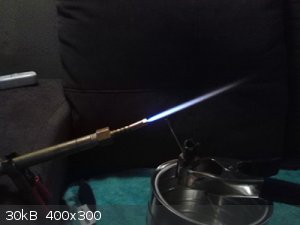
This is a thick steel reducer that I cut in half. Then I realized the camera was just a big white screen so I had to let it cool (you can see the back
where it snapped off)
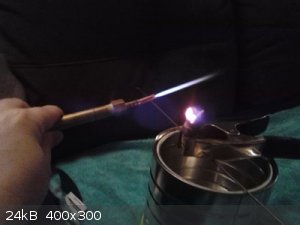
This is my HHO torch which is semi-dismantled at the moment.
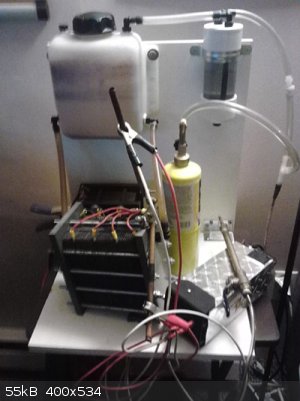
THIS is what I need feedback on. I built 2 retorts. 1 big that's not done yet and 1 small. This is my smaller one that I want to begin doing larger
chargers in (25+gms).
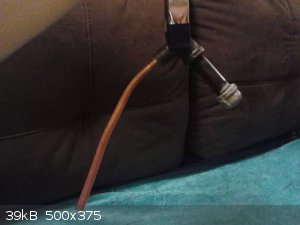
It's crude but I'm gonna hit the back cap with MAP gas and the middle with a cooled burst of HHO. I did NOT weld the copper distiller to the steel
because the threads on that adapter connect to my bigger retort (it can be reversed for larger hundred gm charges).
What I did to connect the copper pipe is put it in the reducer with a small gap around the pipe (like 2mm). Then I used a small flat screwdriver and
quite a bit of AL foil to pack it in tight all around the pipe down to the bottom. After that I poured SiO2 dust all around the pipe. Then I hammered
the dust down hard ass possible going in circles packing it down. Then I put another layer of foil up top and hammered that down to sandwich the SiO2
dust between 2 layers of very tightly packed foil. So basically it's like a rock of SiO2 powder crammed between the pipes that effectively seals out
air. This way down the line when I'm ready to scale I just hammer/wrench out the pipe and connect it to my bigger retort then use the small retort as
the distilling side.
The thing is... I'm a bit worried as to whether a "seal" like this will hold up.
I've seen the amount of smoke just a few gms produces. The first time I tried AL I did it open air in my home with no ventilation... my whole house
filled up with smoke. I immediately opened all the windows and threw fans in. Then I started testing the same volume in my bathroom in a small retort.
With a respirator on my face and small fan vent on the ceiling.
My "ventilation" now is a fan in the window (bathroom fan isn't powerful enough for large charges). I can't do this outside. It's too cold. Nosey
neighbords, etc. So it has to be done inside. I've already heated the pipe with MAP and HHO to see how it holds up and as long as I keep enough
coolant in the line the pipe stays bright orange-yellow and doesn't melt. You can also bang on it and it doesn't deform unless you turn down the MAP
gas. My concern though is at higher weight the reaction itself could melt the AL. Then I'm left with just SiO2 and I'm hoping worse-case-scenario that
will stop any breach of O2.
Finally, I've thought about flooding the retort with CO2 gas. As I saw someone else in this thread do that and that will allow me to test the retort
with smaller amounts first. The problem is he did that around 750C in a testube. I'll be slightly under the melting point of steel (1300C?). From what
I understand, CO2 gas is no longer "inert" at these temperatures. As in, the AL with burn in CO2 like oxygen inside the retort? They say not to put
out MG fires with CO2 so this has to apply to AL as well, right?
Sheesh, so many things that could go wrong I think I'll just start small maybe 15gms and see how that holds up.
My end goal is to build a "quick fire rocket distiller" so safety & engineering are huge concerns here. When I switch to the rocket model I'll
test very small amounts first on video. I know many on here will be concerned with clogging. But I think good engineering will stop that.
If people have thoughts or comments feel free to LMK. 
Thank you!
ps. I realize this thread is extremely old. But this is the ONLY THREAD on the internet that sufficiently covers this topic. And the 1 thing this
thread really lacks is videos. So even if my hypotheses are wrong at least others will get to see this done on video in detail. With me tweaking as
many variables as possible till I'm hitting 80% yields both consistently & efficiently as possible... in a way that is accessible to most people
(my end goal is to make this work with only air-MAP and no HHO). Wish me luck. :-)
pss. I will continue with pics only until my cam arrives.
[Edited on 9-2-2016 by BluePlanet1]
|
|
|
| Pages:
1
..
46
47
48
49
50
..
60 |